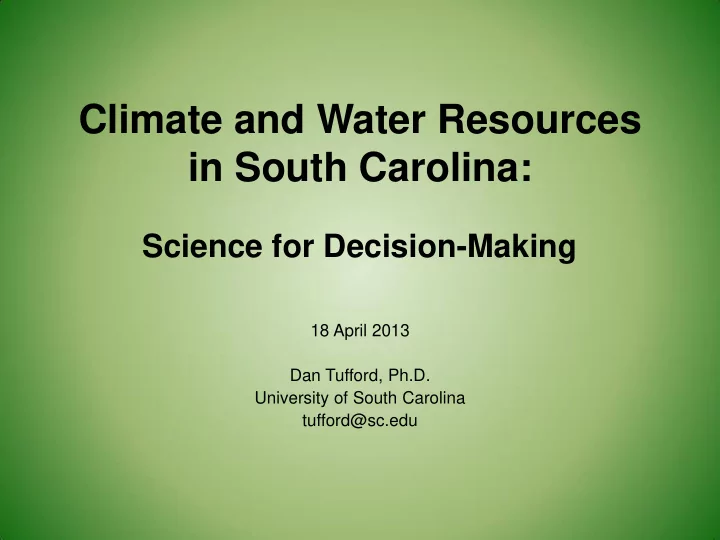

Climate and Water Resources in South Carolina: Science for Decision-Making 18 April 2013 Dan Tufford, Ph.D. University of South Carolina tufford@sc.edu
Science for Decision-Making “The job of a scientist is to make sure that information is provided clearly and appropriately, so people can make a better decision.” Mark Jacobson Professor, Civil and Environmental Engineering Stanford University
Objectives Provide insight into how science goes about addressing policy and management questions Articulate a few of the critical water / climate issues Provide examples of research and tools that seek to address the issues
Acknowledgements Collaborators Greg Carbone – USC Geography Kirstin Dow – USC Geography Paul Conrads – US Geological Survey Jessica Whitehead – SC Sea Grant Consortium John Kupfer – USC Geography Geoff Scott – NOAA CCEHBR Jan Moore – NOAA CCEHBR CISA team Many stakeholder groups Several graduate students Funding – NOAA, NPS, NIDIS
Carolinas Integrated Sciences and Assessments (CISA) Part of Regional Integrated Sciences and Assessments (RISA) program NOAA Climate Program office CISA conducts research in collaboration with water and coastal stakeholders across the Carolinas to produce usable, useful, and accessible climate information for decision making
Carolinas Integrated Sciences and Assessments (CISA) Potential users of this information municipal water supply planners natural area/refuge managers regulatory staff involved in mitigation or restoration activities coastal emergency planning staff Focus areas include drought, watershed and climate modeling, coastal climate, health, and adaptation. Web site – http://www.cisa.sc.edu
Water resource / climate issues • Through the climate lens – Impact of variability • seasonal, interannual, long-term – Impact of extreme events, e.g. • Drought • Tropical storms – Sea level rise • Resource management – Domestic water supply – Wildlife habitat – Reservoir management – Adaptation / mitigation – Water related regulations, e.g. • Water quality, wetlands – Land use change Lake Marion Sparkleberry Cut, Oct 2007 (www.dnr.sc.gov)
Research / tools • Topics – Global climate anomalies • El Niño Southern Oscillation (ENSO) • Atlantic Multidecadal Oscillation (AMO) – Long-term climate change – Sea level rise – Water supply – Public health – Habitat management • Some of this is current, ongoing work
ENSO / AMO • ENSO phases – Sea surface temperature • tropical Pacific Ocean – Cool, neutral, warm phases – Short to medium duration – Global effects on weather • Regional variability • AMO – Sea surface temperature • Northern Atlantic Ocean – Cool and warm phases – 20 – 40 years duration
ENSO / AMO • ENSO / AMO interaction in NC / SC – Precipitation and streamflow • 1950 - 2012 – Seasonal variability – Subregional variability • Winter / spring streamflow – Greater during warm ENSO • Only if warm AMO also • Autumn streamflow – Greater at coast during cool ENSO • Unrelated to AMO – Greater in Piedmont during cool ENSO • Only if warm AMO also
Watershed streamflow modeling • Hydrologic Simulation Program-Fortran (HSPF) • Simulate daily streamflow • Also working with water quality • Calibrate at sub-HUC8 scale • Can address questions – Whole basin – HUC 8 – Local watershed
Surface salinity intrusion PRISM2 model
Climate downscaling for the watershed model Source: Conrads et al (2013) • We used five different GCMs – spanning a range of predictions • Two simulation periods • Historic 1981 – 2010 • Future 2041 – 2070
PRISM2 gage locations
PRISM2 results 14 year simulation
Winyah Bay watershed Additional projects • Current • Vibrio analysis • Future • Salinity impacts on coastal habitat • Salinity intrusion indicator
Congaree National Park
Congaree National Park (CNP) • Impact of changing flows on CNP ecosystems • Three components – Watershed scale streamflow simulation - HSPF – Floodplain hydraulics model - TUFLOW – Ecosystem impacts • Future climate scenarios – Derived as for Winyah Bay models
Study Area Surface water salinity intrusion TN NC Google Maps, 2012 SC Floodplain habitat in Congaree National Park
Daily discharge: GFDL General Circ. Model LtPeeDee_his LtPeeDee_fut JULY LwYadkin_his LwYadkin_fut SFork_hist SFork_fut Waccamaw_his Waccamaw_fut Lynches_his Lynches_fut Black_his Black_fut 0 2000 4000 6000 8000 10000 12000 14000 LBroad_hist LBroad_fut 0 10000 20000 30000 40000 50000 Prec Tmax Tmin LtPeeDee_his LtPeeDee_fut LwYadkin_his LwYadkin_fut SFork_hist SFork_fut Waccamaw_his Waccamaw_fut Lynches_his Lynches_fut Blac_his Black_fut 0 2000 4000 6000 8000 10000 12000 14000 JANUARY LBroad_hist LBroad_fut 0 10000 20000 30000 40000 50000
Daily discharge: ECHO General Circ. Model LtPeeDee_his LtPeeDee_fut JULY LwYadkin_his LwYadkin_fut SFork_hist SFork_fut Waccamaw_his Waccamaw_fut Lynches_his Lynches_fut Blac_his Black_fut 0 2000 4000 6000 8000 10000 12000 14000 LBroad_hist LBroad_fut 0 5000 10000 15000 20000 25000 30000 35000 40000 Prec Tmax Tmin LtPeeDee_his LtPeeDee_fut LwYadkin_his LwYadkin_fut SFork_hist SFork_fut Waccamaw_his Waccamaw_fut Lynches_his Lynches_fut Blac_his Black_fut JANUARY 0 2000 4000 6000 8000 10000 12000 14000 LBroad_hist LBroad_fut 0 5000 10000 15000 20000 25000 30000 35000 40000
Aggregation Rhee, J., G. J. Carbone, and J. Hussey. 2008. Drought index mapping at different spatial units. Journal of Hydrometeorology DOI: 10.1175/2008JHM983.1.
Questions / discussion
Recommend
More recommend